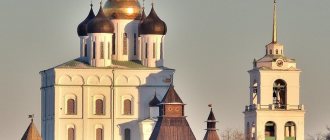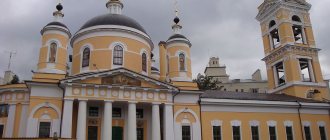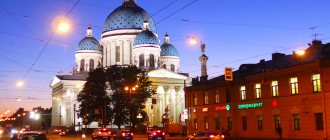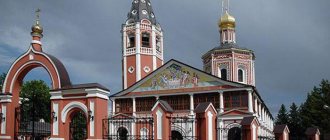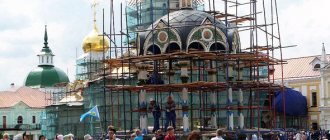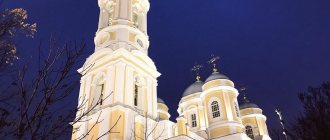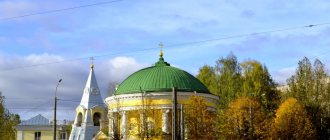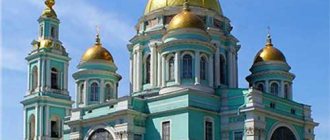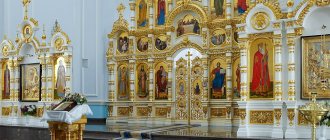Usually, when I go to see another ancient Russian fortress, I associate it, first of all, with walls and towers. I most often perceive internal buildings as separate objects, especially when it comes to churches. However, there are exceptions to all rules, and one of them was the Pskov Holy Trinity Cathedral. Pskov is generally unique in this sense, since its churches are more than just places of worship.
In addition to the fact that they supported the morale of the Pskov residents during sieges, some of them were also entrusted with administrative functions - in particular, the Trinity Cathedral. Until the 16th century, Pskov was a trading republic, and on Vechevaya Square, right in front of the temple, princes were elected and other decisions important for the townspeople were made.
History of the first Trinity Cathedral
The location for the main city church was chosen by Princess Olga herself.
She was a native of these lands and visited the city in the middle of the 10th century. The ruler examined Pskov and ordered the construction of a wooden Holy Trinity Church on the elevated spit of Velikaya and Pskova, protected by earthen ramparts and palisades. For the construction of the temple, she sent “a lot of gold and silver” from Kyiv.
Bird's eye view of the cathedral
The construction of a Christian church in those days is a remarkable fact in itself, because at that time Christianity did not yet have the status of a state religion. It is not known what the wooden Trinity Church looked like, since neither its descriptions nor images have been preserved. The first cathedral stood in Krome until the 12th century, when it was destroyed by a strong fire.
LiveInternetLiveInternet
Quote from Oksana_Lyutova's message
Read in full In your quotation book or community!
In the old days, the question of where to build a city was approached with special concern. A huge hill, stretching from north to south for four hundred meters, rose between two rivers - the Velikaya and Pskova. During floods, river waters flooded the lowlands, and the hill turned into an impregnable island. On this hill the Krivichi Slavs founded the glorious city of Pskov.
More than ten centuries ago, every merchant ship stopped at this steep hill; ships loaded to the brim considered it an honor to enter the local harbor on the way from Scandinavia to Byzantium and back. Historians would later call this path “from the Varangians to the Greeks,” and the city itself would become one of the most powerful fortresses of the Middle Ages. It will be called “Krom” because it stands on the edge, on the edge of the cape.
From a bird's eye view, the Kremlin hill resembles a triangle, a peninsula surrounded by water. These were the northwestern borders of Rus', just a stone's throw from Europe. German knights compared Pskov with Rome, and the secretary of the Polish king Stefan Batory, Jan Piotrovsky, in his diary, which he kept during the siege of Pskov, wrote the following words: “God, what a beautiful city, just like Paris, help us cope with it.”
The official founding date of Pskov is 903.
The fame of the city spread far beyond the borders of Rus', and the city itself grew and developed. Many enemies wanted to capture the city: first the Swedes, then the Poles and Germans, then again the Swedes approached the Pskov Kremlin, barely giving its inhabitants a break. The medieval city lived in constant anticipation of uninvited guests. From the 10th to the 17th centuries, Pskov withstood more than thirty sieges.
The impetus for the development of the settlement was also given by the conquerors - these were the Normans. In the 8th-9th centuries throughout Europe they plied the seas and rivers and controlled waterways. The Scandinavian Vikings built one of their outposts nearby, on the threshold of the village of Vybuty, just 12 kilometers from the Pskov Kremlin. The founder of Pskov, Princess Olga, was also born in Vybuty; she was an educated noblewoman.
Monument to Princess Olga in Pskov.
Already in the 16th century, the length of the stone fortifications of the Pskov Kremlin reached ten miles, which is almost eleven kilometers. Thirty-nine towers rise along the border of the city: sentinel, guard and combat. In the upper reaches and at the mouth of the Pskova River, gratings are lowered, and the Kremlin harbor becomes inaccessible. This defensive fortification was erected by an Italian architect with a Russian name, Ivan Fryazin, who was invited to Pskov. In Europe, almost every castle standing on the river was protected in this way, but for our country, at that time, this was a unique phenomenon.
The Pskov Kremlin is one of the ten “Symbols of Russia”.
To get to the center of the Kremlin you need to go through fourteen gates, the most important ones were called “Great”. One of the most heroic towers of the city is Pokrovskaya. One day this battle tower ended up in the hands of the enemy, the only time in the entire history of medieval Pskov. It was captured by the troops of Stefan Batory during the siege of the Kremlin in 1581. But the enemy could hold out in the Pokrovskaya Tower for no more than a day. Nearby there were two great Pskov cannons, called “Bars” and “Treskotukha”, they fired three hundred kilogram cannonballs at a distance of more than a kilometer. These cannons began firing at the captured tower, which shocked the enemy, because the Europeans did not have such artillery.
The most powerful fortress tower in Pskov.
The underground passages of the Pskov Fortress are absolutely unique fortifications; they were dug everywhere and laid down during the construction of the walls. Through underground passages it was possible to leave the fortress in case of a siege or suddenly appear from underground in front of the enemies and strike. Although initially the underground passages were of particular strategic importance and were called “rumors”. With their help, they listened to see if the enemy was digging somewhere. The warriors walked through the underground passages with a sieve of peas and leaned it against the wall; if they dug somewhere, the walls shook a little and the peas moved. Using this mechanism, it was possible to determine exactly where the tunnel was being dug from.
Walled-up entrances to the Pskov dungeons are scattered throughout the city; small arched vaults are found not only in the center, but also far on the outskirts. The secrets of the underground passages have yet to be unraveled, because there, in fact, an entire city was built underground.
In terms of fortifications, in the Middle Ages, the Pskovites had no equal; their engineering military thought was ahead of its time. The most vulnerable place of any fortress, the gate, was reliably protected by Pskov craftsmen with a real trap, which was called “zahab”, from the ancient Russian word “okhaben”, which means “sleeve”. Zahab is a long winding corridor with high walls, the enemy got here, but there was no chance of getting out. The dark gates closed behind the enemy’s back, and where the walls narrowed, another gate awaited him, and from the high walls stones, arrows and hot tar poured into the enemy.
The zakhabs of Russian fortresses were 20-40 meters in length.
Next to the “Great Zahab” and the main gate, there is now an open-air museum. These are the remains of the Dovmont city, the second ring of stone fortifications of the Pskov Kremlin. Archaeologists excavated this city in the fifties of the 20th century. It turned out that the place of trade, a small piece of land, literally became holy for Pskov residents in a short period of time. All seventeen excavated buildings are temples; such a phenomenon did not occur in any ancient Russian city. At the site of the Dovmontov city, archaeologists discovered well-preserved evidence of the military past: armor, arrows, spears and cannonballs.
The name of the city comes from the name of the Pskov prince Dovmont.
Trinity Cathedral is the main shrine of the Pskov land; it can be seen long before entering the city. The veche met in front of the Trinity Cathedral, here the Pskov princes were crowned princes, here the Pskov governors were blessed to fight the German knights, here in the Trinity Cathedral a casket with documents of the Pskov Veche Republic was kept. In the history of Christianity in Rus', Pskov played a vital role. After all, its founder, Princess Olga, became not only the first woman to rule the state, but also the first to receive Baptism in Rus', long before the baptism of the entire state.
The first, wooden cathedral, was built in the 10th century by Princess Olga.
With the rooting of the Christian faith, many monasteries appeared around Pskov; by the middle of the 16th century there were already dozens of them. Now there are thirteen spiritual centers in the Pskov region, of which the most significant is the Holy Dormition Pskov-Pechersky Monastery. Even on ancient icons he was depicted next to the Pskov Kremlin, although the distance between them was about fifty kilometers. When founding the monastery, the monks chose an unusual place. After all, most often monasteries were built on a hill, but here everything is exactly the opposite, the monastery grew up in a lowland.
The first monks appeared here in the 15th century, and since then, the monastery has never been closed.
The first hermits settled in the caves they dug, hence the name “Pechory”. Today, the caves of the Pskov-Pechersky Monastery are a huge necropolis in which more than ten thousand people are buried. From the entrance there are seven long corridors, the temperature here does not rise above +5C, this is one of the phenomena of the Holy Caves. Not only the ascetics of the monastery, but also laymen of noble and merchant families were buried in the caves. One of the ancestors of Alexander Sergeevich Pushkin is buried here.
The caves were first mentioned in 1392.
Surprisingly, the first temple of the monastery was also built actually underground in the rock. Throughout its centuries-old history, the Church of the Virgin Mary has not been strengthened or rebuilt, the rock turned out to be so reliable. The Pskov-Pechersky Monastery, like the Pskov Kremlin, was also forced to turn into an impregnable fortress; walls and towers surrounded the brethren in the 16th century, during the war with Livonia. The monastery turned into a grandiose defensive structure, which in the 16th-17th centuries had to be defended no less than Pskov.
The Assumption Cave Church is the most ancient temple of the monastery.
Under Peter I, the military importance of the monastery increased significantly; the emperor lived here for several months and worked on fortifications. His cell was located in the Petrovskaya Tower. On the personal instructions of the emperor, a hill was built in the monastery. Since smoking is a sin and is not allowed in the monastery, in order not to go beyond the walls of the monastery, Tsar Peter decided to be above them. Therefore, he went to the top of the mound to smoke his famous pipe.
Order chambers
Trinity Gate
Zahab and Trinity Tower
The first belt of southern defense is the 20-meter Perseus wall. Its restoration was carried out on the orders of Emperor Nicholas I. The autocrat visited Pskov in 1837.
Dovmont Tower
Fortress wall
Corner tower, called Kutekroma
Krom was built at the confluence of two rivers, the Pskov and the Velikaya.
Trinity Cathedral
The domes of the Holy Trinity Cathedral are the highest point in Pskov. In clear weather they are visible throughout the area for several kilometers.
via
Second Council
After the fire, it was decided to build a second temple of stone. In 1138, it was founded by the grandson of the Kyiv prince Vladimir Monomakh - the Novgorod prince Vsevolod Mstislavovich, who is revered by the Church as Saint Vsevolod of Pskov. It is known that the new cathedral was built by Smolensk architects invited to Pskov. At that time, the city did not yet have its own builders, and the Pskov architectural school emerged later.
View of the cathedral from the opposite side of the Velikaya River
The second temple became the place where Prince Alexander Nevsky prayed before the famous Battle of the Ice (1242).
This tradition was adopted by other rulers. Pskov occupied a border position and was often at the center of military conflicts, so prayers for victory to the Pskov army began to be held regularly in the temple.
In the main cathedral of Pskov, the Lithuanian prince Dovmont converted to the Orthodox faith, who took the name Timofey at baptism. Later, the prince's sword was kept in the cathedral altar. It, as a symbol of power, was presented to all rulers who ascended the Pskov throne. And today this historical relic can be seen in the city museum-reserve.
View of the cathedral from the Dovmont Tower
In the Middle Ages, in front of the temple there was the Vechevaya Square, where the main events of the social life of ancient Pskov took place and the veche gathered to decide the fate of the townspeople. Here princes were called to the Pskov throne and mayors were elected. Nearby stood the princely court, in which the rulers of the city lived. Princes, members of their families, as well as high priests were buried in the basement of the temple.
At this time, the Holy Trinity Cathedral had a special two-story vestibule - the Seni. The façade of the beautiful Senya looked out onto the Vecheva Square from the south side of the cathedral building. The meetings of the State Council were held in the narthex, and the secular court also worked. The cathedral kept a chronicle, kept the treasury, the state seal and a chest with archival documents and contracts.
View of the northern façade of the cathedral
A few final words
Any fortress is, first of all, a monument of defensive architecture. However, it must be remembered that in the Middle Ages people sincerely believed that the intercession of higher powers could provide no less help in battle than walls and towers. That is why in every fortress, be it the ancient Russian Kremlin or a Western European citadel, there was invariably at least one cathedral or just a church.
When it comes to Pskov, the Kremlin, the Trinity Cathedral and the walls of the Okolny town, I equally perceive them as part of a single fortification system that provided the Pskov residents with both physical and spiritual protection. The Church of the Holy Trinity is a full-fledged calling card of the city and not a single album dedicated to the beauties of the Pskov land is complete without a photo of the Trinity Cathedral. Pskov is a place where religion from time immemorial was perceived not as a system of prohibitions, but as the basis of the free spirit of the Pskov people.
Third Council
In 1363, the vault of the dilapidated temple collapsed, and two years later a third cathedral was built on the ancient foundation, which was destined to stand for almost 250 years.
More information has been preserved about the architecture of the first two stone cathedrals than about the first temple itself. What they looked like can be judged from the images left on ancient icons. They show that the second temple was single-domed, and the third had three domes.
At the beginning of the 17th century, another devastating fire occurred in the city, which also captured the territory of the Kremlin. The cathedral building burned down almost completely. Only the tomb of Prince Dovmont and the relics of St. Vsevolod of Pskov survived. These were difficult times in the history of Russia, troubled times when the state suffered from the invasion of Lithuanian-Polish troops and internal strife. The Russian lands were devastated, there were no funds for a major restoration of the cathedral, so the temple was only slightly renovated.
View of the cathedral from the opposite side of the Pskov River
Walls of the Pskov Kremlin.
The walls of the Pskov Kremlin are about 9 kilometers long. They fence historical buildings on all sides and make the fortress impregnable. The height of the walls is about 6-8 meters, and the thickness ranges from 2.5 to 6 meters. There are walking platforms on top of the Kremlin walls. The longest is the eastern wall, its length is 435 meters. The shortest is the southern wall of the Pskov Kremlin, which is called “Persi”. Its length is 88 meters.
The Pskov Kremlin (Pskov Krom) is the greatest asset of Russia. This is a unique ancient structure with extraordinary architecture and excellent defensive capabilities. In 2013, the Pskov Kremlin was deservedly included in the list of 10 symbols of Russia.
Did you like the article? Share with your friends:
Fourth Council
In 1682, under Metropolitan Markell, it was decided to build a new cathedral, using the foundation of the old building and lime hewn slabs. Construction lasted for 17 long years and was completed in 1699 under Metropolitan Joseph.
The fourth cathedral was an order of magnitude higher than its predecessor and reached 78 m. For that time it was a very large-scale construction, and the high temple was visible from any part of Pskov. From documents from the beginning of the last century it is known that the heads of the Holy Trinity Cathedral were visible from a distance of 56 miles.
View of the cathedral from the Great Gate
Several decades after its construction, the massive structure began to settle unevenly, so the open galleries on its sides were filled with bricks. And in order to strengthen the temple and prevent its possible destruction, buttresses were built around the quadrangle in 1770. Then the outer walls of the cathedral were plastered, and it became the way we can see it today.
After the arrival of Soviet power, the cathedral was given to believers from the schismatic “Living Church”. In 1935, at the height of the anti-church campaign, the main Pskov temple was closed, and an anti-religious museum was built inside it. Many ancient shrines were placed in the city museum-reserve, and they continue to be kept there to this day.
Bell tower of the Trinity Cathedral
Before the start of the Great Patriotic War, church services were not held in the cathedral. Then Pskov was occupied by German troops, and in August 1941, the new administration under the auspices of the Pskov Religious Mission allowed believers to return to the temple. Since then, Trinity Cathedral has never been closed.
Periods
The second Trinity Cathedral (Pskov) had three chapters and two chapels. Its walls were completely painted with frescoes; the architecture had many techniques of wooden architecture. The craftsmen tried to abstract as much as possible from the Novgorod traditions inherent in the previous building. Their main goal during the design was the opportunity to show the freedom and independence of the city of Pskov.
The modern, fourth, Holy Trinity Cathedral took seventeen years to build. The building was commissioned only in 1699.
The current Trinity Cathedral (Pskov), although it was built on the basis of the previous building, has grown significantly. Its height is 78 meters.
The traditions of Moscow architects of the seventeenth century also had a fairly large influence on the appearance of the temple. For example, the main part was a six-pillar elongated quadrangle. It is crowned with five chapters, which symbolize Christ, as well as the four Evangelists. At the end of the eighteenth century, due to the uneven shrinkage of the cathedral, cracks appeared on it. Therefore, it was decided to lay open side galleries, and strengthen the cathedral building itself with buttresses. From 1894 to 1895, the outer part of the building was plastered.
Architectural features and interiors
The snow-white cathedral was built in the Russian-Byzantine style. Its basis is a six-pillar quadrangle, shaped like a vertically elongated cube. The pillars rest on girth arches. At the top of the temple there are five massive domes. It is curious that they do not stand in the middle, but closer to the eastern part of the cathedral. According to Christian tradition, the five domes are dedicated to Jesus Christ and the four Evangelists. The central chapter of the cathedral sparkles with gold, while the other chapters are painted gray.
The cathedral building is adjacent to two chapels and a closed gallery connected to the vestibule. The lower tier most likely served as the basement of the old cathedral. Since 1903, it has housed a church consecrated in honor of Seraphim of Sarov, and behind its altar there is an ancient tomb. To get to the upper tier, you need to climb the porch and wide stairs.
Not far from the cathedral there is a white bell tower with a clock. It appeared later than the cathedral (XVIII century). The tall building is crowned with a pointed spire. The bell tower was built in the traditions of classicism, but despite this, it forms a harmonious architectural ensemble with the temple.
There are no wall paintings inside the cathedral - they burned down during a fire in the 17th century. However, the interiors of the temple are decorated with a huge iconostasis with gilded carvings. In the cathedral you can see a large modern icon “The Cathedral of Pskov Saints”
, which depicts Christian ascetics of the Pskov lands led by Princess Olga.
Current status and visiting hours
The cathedral is open any day from 8.00 to 20.00. Entrance to the territory of Krom and to the cathedral itself is free. Church services are held here twice a day in all four limits - Trinity, Kazan, Alexandrovo-Nevsky and Serafimovsky. The evening services (5 p.m.) are especially beautiful, when the bishop's choir sings.
Interior of Trinity Cathedral
In the Holy Trinity Cathedral you can see the relics of Christian saints, a piece of the Intercession of the Virgin Mary and icons, the oldest of which were painted in the 16th century. A special place is occupied by a rich shrine where the remains of St. Vsevolod of Pskov are kept.
The temple holiday in the cathedral is considered to be the day of remembrance of Princess Olga. It is celebrated with a large crowd of people on July 11th.
Structure:
The design of the iconostasis of the Trinity Cathedral is simple, yet strict and unpretentious - a sort of rectangular grid consisting of columns and cornices. The central icons are larger, the size of the opening of the Royal Doors. The finish of the icons here is different: rectangular, oval, trapezoidal.
Initially, in the 17th century, 5 tiers of the iconostasis were created, their ranks: local, festive, deesis, prophetic and forefathers. Then, almost a century later, two more were added, which depict the Passion of the Lord and the Crucifixion with those to come.
The most solid tier is the bottom one; to some it resembles a base. Ancient sages and philosophers are depicted there. In the hands of each of them are packages, on them are prophecies. At the Royal Gate there are icons of the “Savior Not Made by Hands” and “The Word Was Flesh.” On the gate itself there are icons of Seraphim of Sarov and Nikander of Pskov. Both of these saints prayed fervently and lived as hermits for a long time.
How to get there
The ancient cathedral occupies the central part of the Pskov Kremlin. It is located in the historical center of Pskov, north of the Olginsky Bridge over the Velikaya. The territory of the Kremlin has the status of a pedestrian zone, where entry for any transport is not allowed. Around the city you can get to the Kremlin by buses No. 1, 7, 7A, 11, 15, 18, 19, 25, 30, as well as by minibuses No. 4A, 51, 51A (stop “Lenin Square”).
Attraction rating:
Rating 4.60 [5 vote(s)]
| ← PSKOV | PSKOV REGION | RUSSIA → |
Towers of the Pskov Kremlin - names.
The towers of the Pskov Kremlin are located along the perimeter of the structure, there are seven of them in total. They are tall, powerful stone buildings with defensive platforms. Some of these towers are the cultural heritage of the Russian Federation, objects of federal significance. For example, the northern tower of Kutekrom is the oldest on the territory of the Pskov Kremlin. Also on this territory there are Vlasyevskaya, Rybnitskaya, Troitskaya, Dovmontova, Ploskaya and Middle towers. Unfortunately, the Pskov Kremlin had to endure another fire, threatening to destroy its architectural heritage. In 2010, the Vlasyevskaya and Rybnitskaya towers were damaged by flames.
